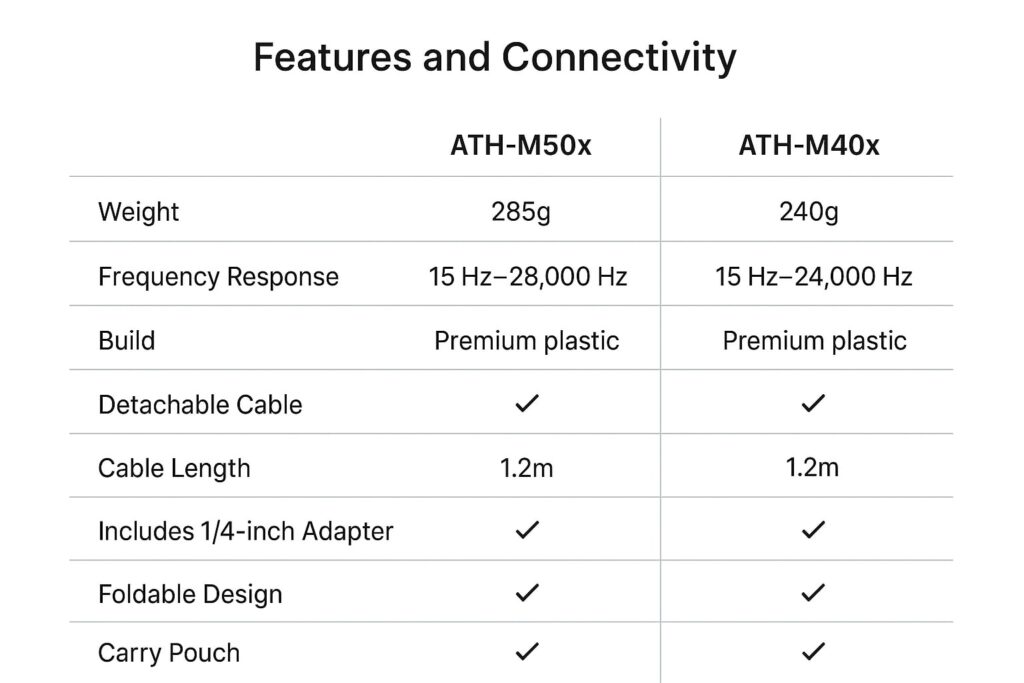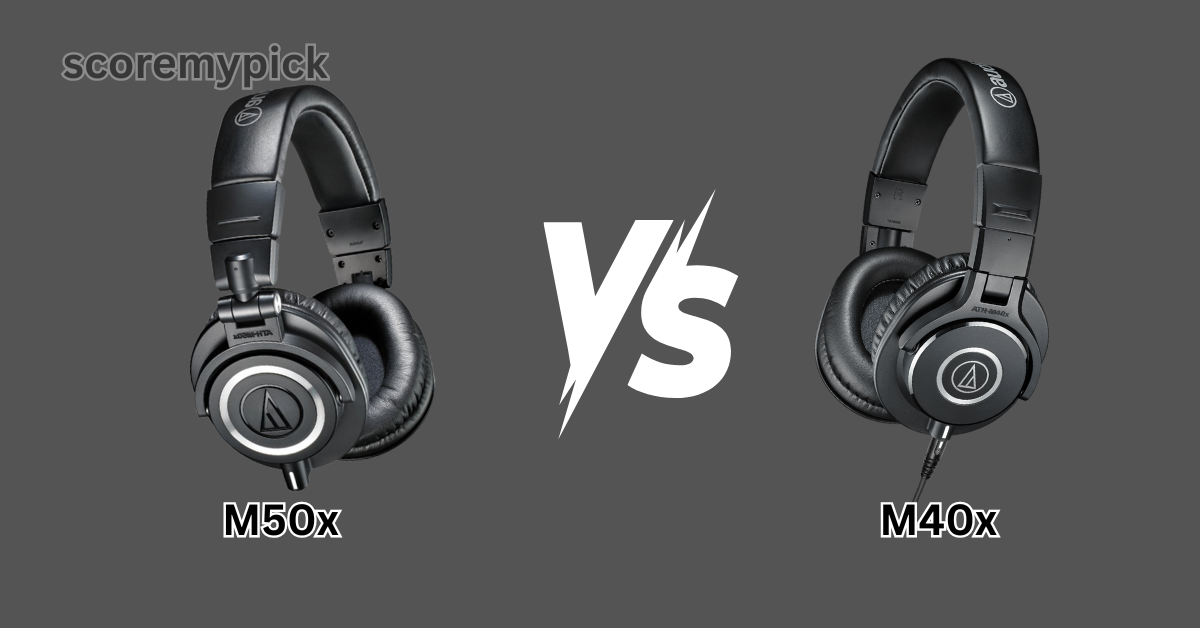Audio Technica attained success with the ATH M-Series, which can be considered professional headphones that fall into a middle price range with respect to being affordable and quality.
Among these, M50x and M40x are the most-discussed ones. Both are common in studios, in the hands of DJs and content creators and those who want to hear tunes accurately.
At a passing glance, they may seem the same, but there is more to it in terms of sound quality, comfort, build and value. In this paper, we will explain everything step by step – some of the factors that will help you decide on the pair you need.
Introduction to the Audio Technica ATH M-Series
Audio Technica entered the ATH M-Series with one specific purpose: to provide professional-quality sound at a price that anyone could afford. These headphones won the world over recognition because of their clarity, robustness and studio precision. M50x, released in 2014, was the mysterious successor of the M50.
It has a wide frequency response with a slightly bass-forward signature and has become one of the modern classics. The M40x (released in 2014) also has a more open, less colorful sound, which means it is suited to a more neutral sound and lower prices, thus especially appealing to audio professionals and cost calculations.
The M-Series stands for:
- M for Monitor – built for studio monitoring and critical listening.
- Numbering System – higher numbers usually mean more advanced sound tuning and a premium build.
The M50x is considered the flagship of the line, while the M40x provides an excellent balance between affordability and studio accuracy. Together, they dominate headphone comparison charts, leaving many people wondering which one is the smarter buy.
Design and Build Quality Comparison
Design-wise, the ATH M50x and the ATH M40x both have a professional studio appearance. You could easily be fooled into thinking they were the same, but on closer examination, you would see that there are some important differences.
Materials Used: Both headphones are primarily made of durable plastic, with metal reinforcements inside the headband for stability. The ear pads are covered in synthetic leather that feels soft to the touch. However, the M50x has slightly thicker padding, giving it a premium edge.

Weight: The M50x weighs around 285 grams, while the M40x is lighter at 240 grams. This difference may seem small, but during long listening sessions, the lighter build of the M40x reduces strain on the head and neck.
Ear Cup Rotation and Foldability: Both headphones feature swiveling ear cups that rotate up to 90 degrees, making them easy for one-ear monitoring or folding flat for storage. The M50x, however, has a more flexible design for DJs and studio professionals.
Durability: In terms of toughness, both models are built to handle daily wear. The clamping force is slightly tighter on the M40x, which helps with isolation but can feel firm for some users. The M50x offers a better balance between snug fit and comfort.
Verdict: The M40x wins in lightweight portability, while the M50x feels more premium and versatile for professional use.
Sound Quality Face to Face
Sound quality is the area where the argument between the two models turns out to be the most intense one. Both headphones provide high monitoring quality sound; however, the filters and frequency response are tailored to listeners of different categories.
- Frequency Response:
- M50x: 15 Hz – 28,000 Hz
- M40x: 15 Hz – 24,000 Hz
- This extended range in the M50x means deeper bass and more detailed highs.

- Bass Performance: The M50x delivers punchier bass with a slight emphasis, making it great for EDM, hip-hop, and modern pop music. The M40x, on the other hand, keeps bass controlled and neutral, better for mixing and accurate playback.
- Mids and Vocals: Both models handle mids clearly, but the M40x stays flatter and more neutral, making vocals sound true to life. The M50x sometimes gives a warmer touch, which casual listeners often enjoy.
- Treble and Highs: The M50x extends higher, offering brighter detail. This helps capture finer elements in instruments like cymbals or strings. The M40x keeps the treble smoother, reducing listening fatigue during long sessions.
- Soundstage: Neither headphone offers the widest soundstage since they are closed-back models, but the M50x provides a slightly more spacious feel thanks to its tuning.
Verdict: The M50x excels in lively, engaging sound with deeper lows and brighter highs, while the M40x offers a neutral, balanced profile ideal for mixing and professional editing.
Comfort and Ergonomics Over Time
Comfort is an aspect of the headphone that you have to take into consideration, especially when using them in a studio session or during gaming or listening to music over an extended period. Both the ATH M50x and M40x are made with padded ear cups and adjustable headbands; what differs is how well they are built to wear long-term.
Weight:
- M50x – 285 grams
- M40x – 240 grams
- That 45-gram difference may not look like much on paper, but in practice, the M40x feels noticeably lighter, making it easier to wear for 4–6 hours straight without discomfort.
Ear Cup Size: The M50x ear cups are slightly larger, giving more room around the ears. This helps reduce ear fatigue for people with bigger ear shapes. The M40x fits snugly and can feel tighter during extended use.
Padding and Cushioning: Both headphones use synthetic leather pads. The M50x pads are softer and thicker, while the M40x pads feel firmer. After long use, the M50x tends to provide more comfort, though both may require pad replacement after 1–2 years of daily use.
Clamping Force: The M40x applies stronger pressure for better noise isolation, but that can lead to slight discomfort during long hours. The M50x balances grip and comfort more effectively.
Verdict: If you need lightweight comfort for extended hours, the M40x wins. If you prefer softer padding and a looser fit, the M50x feels more luxurious in the long run.
Features and Connectivity Options
While both headphones share the same professional design language, their features are slightly different, making them more or less practical depending on how you use them.
Detachable Cables: Both the M50x and M40x come with detachable cables, which is a huge plus for durability.
- M50x includes three cables: 1.2m straight, 3m straight, and 1.2m–3m coiled.
- M40x includes two cables: 3m straight and 1.2m–3m coiled.
- This gives the M50x more flexibility straight out of the box.
Ear Cup Swivel:
- M50x – ear cups rotate 90 degrees both ways, making it versatile for DJs and one-ear monitoring.
- M40x – ear cups rotate 90 degrees one way only, limiting flexibility.
Bluetooth Options: Both models are wired by default, which ensures zero latency and accurate monitoring. However, the M50x also has a Bluetooth version (M50xBT) available, giving users a wireless option, while the M40x remains strictly wired.
Noise Isolation: Neither has active noise cancellation, but their closed-back design provides decent passive isolation, cutting outside noise by about 30–40% in average environments.
Verdict: The M50x offers more cables, more swivel flexibility, and an optional Bluetooth model, making it the better choice for versatile users. The M40x keeps things simpler but practical, especially for studio-only use.

Price and Value for Money
Price often becomes the deciding factor when choosing between the ATH M50x and ATH M40x. While both offer great performance, their cost creates a clear separation in value.
Retail Price Range:
- ATH M50x: around $149 – $169 depending on region and discounts.
- ATH M40x: around $99 – $119, making it around 30–40% cheaper than the M50x.
Price-to-Performance Ratio:
- The M40x delivers about 80–85% of the performance of the M50x at a much lower cost. For beginners, students, or budget-conscious buyers, this makes it one of the best deals in the studio headphone market.
- The M50x, while more expensive, justifies its price with wider frequency response, better bass depth, more accessories, and versatility (like the Bluetooth version).
Market Position:
- The M40x is often called the “budget audiophile choice”, delivering professional sound for under $120.
- The M50x is more of a professional flagship, widely used in studios, by content creators, and even in live DJ setups.
Verdict: M40x makes sense where you are cost-sensitive and want to be accurate without paying extra. M50x will cost you more dollars, but it will provide you with a more detailed and versatile long-term investment.
7. Pros and Cons of Each Model
Every headphone has strengths and weaknesses, and laying them side by side makes it easier to decide.
Audio Technica ATH M50x
Pros:
- Wider frequency response (15 Hz – 28,000 Hz) for deeper bass and brighter highs
- More comfortable ear pads with softer cushioning
- Includes three detachable cables for different needs
- 90-degree ear cup swivel both ways, great for DJs
- Bluetooth version available (M50xBT)
Cons:
- More expensive than the M40x
- Heavier at 285 grams, slightly less comfortable for long sessions
- Bass emphasis may not suit those who want completely flat monitoring.
Audio Technica ATH M40x
Pros:
- Affordable price (around $99–$119) with strong value for money
- Lighter weight at 240 grams, easier for long listening
- Neutral and accurate sound signature, perfect for mixing
- Durable build with solid clamping force
- Includes two detachable cables
Cons:
- Narrower frequency response (15 Hz – 24,000 Hz) compared to M50x
- Ear cups only rotate one way (less flexible than M50x)
- Pads feel firmer, which may cause fatigue in long sessions.
- No Bluetooth option available
Verdict: The M50x is better for professionals and casual listeners who want fun sound, while the M40x is perfect for budget-conscious users and studio accuracy.
8. Final Verdict – Which One Should You Buy
Both Audio Technica ATH M50x and ATH M40x are great models, but your needs determine the most suitable one. The M40x is the most prudent purchase when you desire a Neutral, affordable studio monitor that is comfortable to wear.
It produces almost pro-like accuracy at a price point greater than 120, making it ideal for learning and student tool as well as mixing engineer monitoring.
Conversely, in case you prefer supreme construction, more bass, higher highs, more extras and enhanced flexibility, the M50x may prove the right purchase investment.
It is a long-term headphone that has been tested in world-class professional studios. The M50x can be summed to serve best the DJs, musicians, and audiophiles who seek to engage in sound with details.
Bottom Line:
- Choose M40x if you want value, accuracy, and lightweight comfort.
- Choose M50x if you want premium sound, versatility, and a professional-grade experience.
FAQs
1. Is the Audio Technica ATH-M50x better than the M40x?
Yes, the M50x offers a wider frequency range, deeper bass, and more comfort. However, the M40x delivers around 80–85% of its performance at a much lower price.
2. Are the M40x good for mixing?
Yes, the M40x has a neutral, balanced sound signature that makes it highly suitable for mixing and professional studio monitoring.
3. Do the M50x and M40x have noise cancellation?
No, neither has active noise cancellation, but their closed-back design provides decent passive isolation.
4. Which one is more comfortable for long listening?
M40x is lighter and not as pressing on the head, whilst M50x has softer pads. Comfort is relative to one who favors less weight (M40x) and better cushioning (M50x).


1 thought on “Audio Technica Ath M50x vs M40x”